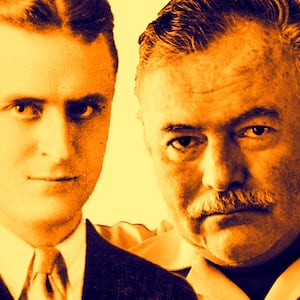“Write drunk. Edit sober.”
This popular quote is often attributed to Ernest Hemingway since, you know, he was happy to have a drink or two.
I’ve never believed A) that he said or wrote it, or B) that he practiced it. In fact, through the bulk of his career, Hemingway categorically stated that he never drank while writing. In an interview in 1958 with Milt Machlin for the magazine Argosy, when asked if it were true that he took a pitcher of Martinis with him every morning on his way to work, Hemingway replied, “Jeezus Christ!…Have you ever heard of anyone who drank while he worked? You’re thinking of Faulkner. He does sometimes–and I can tell right in the middle of a page when he’s had his first one. Besides, who in hell would mix more than one Martini at a time?”
Meanwhile, you have Hemingway’s contemporary and friend, F. Scott Fitzgerald, who actually did admit to drinking while writing. Indeed, he once confided to a friend that he relied on drink to infuse more feeling into his work, that “drink heightens feeling. When I drink, it heightens my emotions and I put it in a story…My stories written when sober are stupid…all reasoned out, not felt.”
So, here you have two of the most successful and revered American prose writers of the 20th century with distinctly opposite views on alcohol.
For the most part, Hemingway didn’t drink while writing. Rather, he drank in his off hours as a way of clearing his head, to relax, and to allow his mind to subconsciously work on the story, so in the morning he could continue his work sober. In everything I’ve ever read written by him and about him, from biographies to letters to memoirs, the only instance where I could find where he admitted to drinking while writing was in A Moveable Feast.
He recalled sitting in a Paris café as a young man, sipping a bit of rum while writing a story “about up in Michigan.” Because “it was a wild, cold, blowing day” and “it was that sort of day in the story…But in the story the boys were drinking and this made me thirsty and I ordered a rum St. James. This tasted wonderful on the cold day and I kept on writing, feeling very well and feeling the good Martinique rum warm me all through my body and my spirit.” Hemingway was probably 23 when he wrote the story “The Three-Day Blow,” to which this memory likely refers, still in his formative years as a writer.
A 1935 letter Hemingway wrote to his friend Ivan Kashkin further reveals his perspectives on drink. “I have drunk since I was fifteen and few things have given me more pleasure. When you work hard all day with your head and know you must work again the next day what else can change your ideas and make them run on a different plane than whisky?…The only time it isn’t good for you is when you write or when you fight. You have to do that cold…Modern life, too, is often a mechanical oppression and liquor is the only mechanical relief.”
Corroborating this, Hemingway biographer Carlos Baker noted in his book, Ernest Hemingway: A Life Story, that Hemingway “explained the nights of drinking as a necessary counterforce to the daily bouts of writing, which left him as whipped, wrung out, and empty as a used dishrag.”
Meanwhile, Fitzgerald reportedly drank copiously while writing. Oddly enough, he initially eschewed drinking while writing when he was in his 20s, or at least he claimed as much. In 1922, at the age of 26, he wrote to his friend Edmund “Bunny” Wilson that “I have never written a line of any kind while I was under the glow of so much as a single cocktail.” Alas, by 1935, the wizened, 39-year-old author admitted to his editor Maxwell Perkins (who was also Hemingway’s editor) that “It has become increasingly plain to me that the very excellent organization of a long book…do not go well with liquor. A short story can be written on a bottle, but for a novel you need the mental speed that enables you to keep the whole pattern in your head…I would give anything if I hadn’t had to write Part III of Tender is the Night entirely on stimulant. If I had one more crack at it cold sober I believe it might have made a great difference.”
In Hemingway’s prose you’ll also find a striking contrast with Fitzgerald. Being proud of his own tolerance levels (he could drink quite a bit without showing any effects), Hemingway tended to create protagonists who could also handle their liquor, who didn’t believe they had a problem with drinking, and for whom alcohol was never their downfall. Only Hemingway’s minor characters had drinking problems, such as the occasional “rummy” in To Have and Have Not and Islands in the Stream.
In The Sun Also Rises, Jake Barnes drinks quite a lot, but it’s to be understood, he has a serious war wound that prevents him from consummating his love for Brett Ashley. Ashley, on the other hand, now she’s the rummy in the story, along with her fiancé Mike Campbell. Brett’s hands shake so badly that when her Martini arrives, she has to sip from it at first as the drink sits on the bar top. “Then she picked it up. Her hand was steady enough to lift it after that first sip.”
In A Farewell to Arms, protagonist Frederic Henry drinks so much while convalescing from his war wounds that he contracts jaundice. But it’s okay, it seems, since he’ll supposedly dial back his drinking once he’s discharged and gets back to a normal life. In For Whom the Bell Tolls, the main character Robert Jordan drinks an occasional absinthe or whiskey to escape the horrors of the Spanish Civil War but his compatriot Pablo, who was once a good man, has been ruined by drink. “He is going bad fast and without hiding it,” Jordan surmises.
In Islands in the Stream, Thomas Hudson uses a bottle of Old Parr Scotch to numb the pain of learning that two of his sons, along with his ex-wife, were killed in a car crash. “He sat in the comfortable chair and read through the pile of papers and magazines and drank the Scotch and Perrier…‘Listen to the whisky talking,’ he said to himself. ‘What a solvent of our problems…Tomorrow I’ll sweat this all out on one of those bicycles that goes nowhere and on a mechanical horse. Then I’ll get a good rubdown. Then I’ll meet somebody in the bar and I’ll talk about other things.’” Drink to get through a bad situation, then tomorrow it’s back on that horse.
The closest you get to any sort of admission that drinking hastened the death of a Hemingway hero is Colonel Richard Cantwell in Across the River and Into the Trees. While it’s a heart attack that kills him, you know that those double Martinis and Negronis he’d use to wash down his nitroglycerine pills didn’t do him any favors.
Conversely, in Fitzgerald’s prose we see plenty of main characters who’ve been destroyed by drinking, just as their creator knew he had. The Beautiful and Damned chronicles the torrid life of Gloria and Anthony Patch, one party after another, a life of dissipation while they await his grandfather’s inheritance. During one afternoon, Anthony entertains his friend Geraldine at his apartment, where he “wheeled out the little rolling-table that held his supply of liquor, selecting vermouth, gin and absinthe for a proper stimulant.”
“You drink all the time, don’t you? Geraldine exclaimed. You have to have something to drink every day and you’re only twenty-five. Haven’t you any ambition? Think what you’ll be at forty.” To which Anthony glibly replies, “I sincerely trust that I won’t live that long.” Indeed, by the book’s end, Anthony is but a shell of his former self, years of excessive drinking have destroyed in him any sense of purpose or ability.
In the short story “Babylon Revisited,” protagonist Charlie Wales revisits the Paris of his irresponsible youth, as well as his daughter Honoria. He’s lost custody of her because of his drunken ways, and it seems that Charlie was also partly responsible for the death of his wife Helen, Honoria’s mother. Honoria now lives with Helen’s very resentful sister Marion, who allows Charlie only an occasional visitation. When Charlie takes Honiria to lunch, he has to select a restaurant that wasn’t “reminiscent of Champagne dinners and long luncheons that began at two and ended in a blurred and vague twilight.” Charlie allows himself but one drink a day, “I take that drink deliberately, so that the idea of alcohol won’t get too big in my imagination.”
Other alcoholic and fallen characters abound in Fitzgerald’s works, notably Dick Ragland in “A New Leaf,” Forrest Janney in “Family in the Wind,” Abe North and Dick Diver in Tender is the Night and Ben Dragonet in “Her Last Case.” Indeed, when reading “One Trip Abroad,” one can’t help but see Scott and Zelda in the characters of Nelson and Nicole Kelly. Upon visiting Paris, the Kellys had to make “a conscientious list of the places they wouldn’t visit anymore and the people they didn’t want to see again. The places included several famous bars, all the nightclubs” for fear of falling into temptation yet again.
Similarly, in “Babylon Revisited,” Charlie Wales eschews the raucous nightclubs of Montmartre, notably “Bricktops, where he had parted with so many hours and so much money.” To go there again, Charlie reasoned, “You have to be damned drunk.”
Fitzgerald’s biographies and memoirs of his cohort are punctuated by stories of his drunken sprees and horrid behavior toward his friends. After ruining yet another dinner party hosted by his friends Gerald and Sara Murphy in Cap d’Antibes (where “during the dessert course, he threw a ripe fig down the back of the princess’s décolletage,” and later tossed several of “Sara Murphy’s prized Venetian glasses, full of liquor, over the garden wall, ruining her tomatoes,” not to mention breaking the glasses), Fitzgerald was banned from their home for three weeks. As noted by friend and author John Dos Passos, “Like many drunks Scott took a malicious pleasure in making his friends uncomfortable.”
Hemingway grew so exasperated by Fitzgerald’s antics that he complained to Maxwell Perkins, “Please don’t under any circumstances give Scott our Paris home address–last time he was in Paris he got us kicked out of one apt and in trouble all the time. (Insulted the landlord–pee-ed on the front porch–tried to break down the door at 3-4 and 5 a.m. etc.)…I am very fond of Scott but I’ll beat him up before I’ll let him come and get us ousted from this place…When I heard he was going to Paris it gave me the horrors.”
But Fitzgerald knew he was a bad drunk, and wove it into his characters. In the short story “A New Leaf” is the autobiographical recognition that “like so many alcoholics, he has a certain charm. If he’d only make his messes off by himself somewhere—except right in people’s laps. Just when somebody’s taken him up and is making a big fuss over him, he pours the soup down his hostess’ back, kisses the serving maid and passes out in the dog kennel. But he’s done it too often. He’s run through about everybody, until there’s no one left.”
Or the drunken sprees, they were woven in, as well. That wild night in Paris when Scott and Zelda “entertained themselves by frivolously racing around the obelisk in the Place de la Concorde in a stolen delivery-cart tricycle?” You’ll find it in “Babylon Revisited.”
Curiously, within each author’s most well-known works, where you perhaps find both writers’ most noble heroes, in Fitzgerald’s The Great Gatsby and Hemingway’s The Old Man and the Sea, the protagonists aren’t really drinkers at all. Sure, Jay Gatsby is a bootlegger, but he only had the occasional cocktail at his lavish parties, wanting to be the consummate host. And Santiago the fisherman? He had but an occasional Hatuey Beer after a long day on the Gulf Stream. Perhaps both authors wished to clad each character with a bulletproof armor of nobility and strength to ensure that each soared above the other characters in the estimation of the reader.
It’s something to contemplate as you sip a favorite drink of both Hemingway and Fitzgerald, the classic (and low-alcohol) Champagne Cocktail, which they often enjoyed at the Ritz Paris.
Here’s how:
Fill a flute with chilled Champagne or sparkling wine. Drench a sugar cube with a few drops of Angostura Bitters. Drop the cube into the flute and watch the torrents of bubbles flowing out of the dissolving sugar cube. Garnish with a lemon peel. Enjoy!







